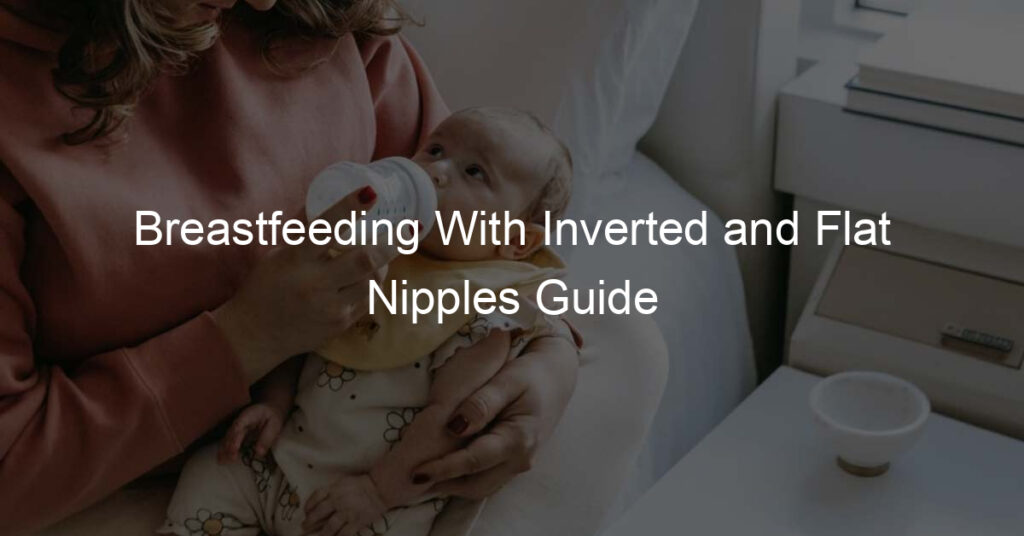Are you a mother considering breastfeeding, but worried about how to manage inverted or flat nipples? Don’t worry – you’re not alone. Many women have nipple concerns before breastfeeding, but there’s no need to let it stand in your way. In this helpful guide, we’ll provide some tips and advice on how to overcome any difficulties and make breastfeeding with inverted or flat nipples a success.
Start reading now to feel prepared and confident about providing nourishment for your baby in the best way possible.
Can you successfully breastfeed with flat nipples?
Breastfeeding can be a daunting task, especially with the added challenge of flat nipples. Although it may seem overwhelming at first, successful breastfeeding is completely possible with flat nipples.
For starters, many women can breastfeed in this situation through a combination of pumping and manual stimulation. Additionally, nipple shields can allow mothers to comfortably breastfeed their newborns while also providing more control over milk flow.
Ultimately, every mom’s situation is unique and so it’s important to work closely with your healthcare provider or lactation specialist — they’ll provide tailored advice specific to you and your baby that will help you both feel more comfortable throughout the entire process.
Can moms with inverted nipples breastfeed?
Breastfeeding is a common concern for new moms, and the challenge can be even greater for those who have inverted nipples. It’s important to know that inversion doesn’t necessarily mean that you won’t be able to breastfeed, as it does not prevent milk production.
Many mothers successfully nurse babies regardless of their nipple shape due to proper preparation and positioning. With the aid of a lactation consultant or healthcare provider, frequently checking correct latch-on and adjusting feeding positions when needed, most nursing journeys can still be successful.
Although challenges may arise along the way, there is no need to be discouraged: inverted nipples are just another one of the many hurdles parents face on their unique paths toward having healthy and happy babies.
What is the best breastfeeding position for inverted nipples?
Inverted nipples can present a challenge to new mothers looking to start breastfeeding, but there are several effective positions to make the process easier.
The best position for breastfeeding an infant with inverted nipples is the football or clutch hold. With this position, the baby can latch on closer to their mother’s chest – providing great comfort and support. She needs to make sure she reclines between 30 and 45 degrees for maximum success as well as positioning either both arms behind the baby’s back or one arm supporting them from beneath and one holding the shoulder.
Additionally, some mothers find that massaging their nipples before trying to feed helps by stimulating blood flow, relaxation of muscles, and alerting the little one of open milk ducts available. With these tips in mind, any mother with inverted nipples should be able to breastfeed without issue!
Can inverted nipples cause a low milk supply?
Inverted nipples can indeed affect the amount of milk that is produced when it comes to breastfeeding. Since the nipples are inverted and point inward, it can make it difficult for a baby to latch onto them and suckle properly. In some cases, this can cause mothers to produce less milk; however, many simple solutions can help resolve the issue.
One example is using breast shells which are specifically designed for inverted nipples, as they gently draw the nipple outward to provide optimal positioning. Additionally, manual expression techniques, such as hand expressing or using a pump, can still be used if latching is difficult.
With all of these methods combined, inverted nipples should no longer be an obstacle that causes any mother’s supply of milk to decrease in production.
What problems can inverted nipples cause?
Having an inverted nipple can cause a great deal of discomfort and embarrassment for many women. It affects both the physical and mental well-being, making certain activities such as swimming or wearing tight clothing difficult, among other challenges.
The problem might also go unnoticed until breastfeeding a baby when it often causes milk collection, drainage, and infection problems. These can lead to extreme pain and damage if not taken care of properly.
In some cases, milk ducts may even become blocked leading to further environmental problems. Therefore, while inverted nipples are a common occurrence that should not evoke alarm, it is important to take appropriate steps to treat them before any negative consequences arise.
Closing Thoughts About Breastfeeding With Inverted and Flat Nipples Guide
Breastfeeding a baby can be challenging, especially when facing unique obstacles such as inverted or flat nipples. However, in such cases, helping the baby latch and properly feed is possible with some adjustments to how the mother holds the nipple during feedings, as well as relying on certain tools and even positions developed for these specific types of nipples.
With the right attitude and determination, women with either an inverted or flat nipple can achieve success at breastfeeding their babies. No matter what shape your nipple is in – small bumps, large lumps, flat disks, or even inverted circles – these tips discussed throughout this post will help navigate through the challenges of breastfeeding with any type of nipple shape.
After all, having positive feelings about breastfeeding does more to improve successful outcomes than any technique alone. With dedication and perseverance, those with differently shaped nipples can succeed just nicely at breastfeeding their precious babies!














